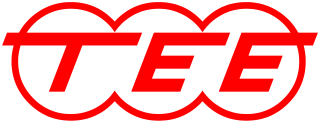
The Trans Europ Express, or Trans-Europe Express (TEE), was an international first-class railway service in western and central Europe that was founded in 1957 and ceased in 1995. At the height of its operations, in 1974, the TEE network comprised 45 trains, connecting 130 different cities, from Spain in the west to Austria in the east, and from Denmark to Southern Italy.
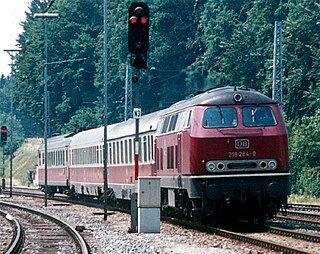
The Bavaria was an express train that linked München Hbf in Munich, Germany, with Zürich HB in Zurich, Switzerland. Introduced in the 1950s, it ran through to Geneva until 1969, when it was cut back to Zurich. The train was named on the basis that Bavaria is the Latin equivalent to the German word Bayern, the official name of the federal state of Bavaria, of which Munich is the capital. It was operated by the Deutsche Bundesbahn / Deutsche Bahn (DB) and the Swiss Federal Railways (SBB-CFF-FFS). The route also included a single stop in Austria, at Bregenz. The 24 km (15 mi) section between Lindau, Germany, and St. Margrethen, Switzerland, is located mostly in Austria, but Swiss locomotives hauled the train over this section, most of which is part of the Vorarlberg line of Austrian Federal Railways.

The Arbalète was an express train that linked Paris-Est in Paris, France, with Zürich HB in Zurich, Switzerland. Introduced in 1957, it was operated by the SNCF and the Swiss Federal Railways (SBB-CFF-FFS).

The Iris is an express train that links Brussels Midi/Zuid in Brussels, Belgium, with Chur station in Chur, Switzerland.

The Helvetia was an express train that, for most of its existence, linked Hamburg-Altona station in Hamburg, Germany, with Zürich HB in Zurich, Switzerland. Introduced in 1952, it was operated by the Deutsche Bundesbahn / Deutsche Bahn (DB) and the Swiss Federal Railways (SBB-CFF-FFS). The train's name, Helvetia, is the Latin word for "Switzerland".
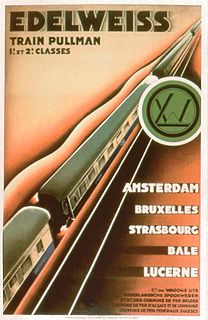
The Edelweiss was an international express train. For most of its existence, it linked the Netherlands with Switzerland, via Belgium, Luxembourg and France. Introduced in 1928, it was named after a mountain flower, the Edelweiss, which is associated with alpinism and the Alps, and regarded as a symbol of Switzerland.

Le Mistral, or the Mistral, was an express train between Paris and Nice in France. Introduced in 1950, it was operated by the Société Nationale des Chemins de fer français (SNCF), and was regarded as the company's flagship train.

The word Rheinpfeil was used to name a number of express trains that ran in Germany between the 1950s and 1991. For much of that period, a train carrying the name Rheinpfeil also linked Germany with at least one neighbouring country.

The Albert Schweitzer was a short-lived express train that linked Dortmund Hbf in Dortmund, Germany, with Strasbourg-Ville in Strasbourg, France. Introduced in 1980, it was operated by the Deutsche Bundesbahn (DB) and the SNCF.

The Prinz Eugen was an express train that linked northern Germany with Wien Westbf in Vienna, Austria. Introduced in 1971, it was operated by the Deutsche Bundesbahn / Deutsche Bahn (DB) and the Austrian Federal Railways (ÖBB).

The Roland was an express train that ran in Germany. For part of its existence, it was also an international train. Introduced in 1939, suspended during World War II, and reintroduced in 1952, it was operated in Germany by the Deutsche Reichsbahn Gesellschaft (DRG), the Deutsche Bundesbahn (DB) and the Deutsche Bahn (DB), respectively.

Le Capitole was an express train between Paris and Toulouse in France. Introduced in 1960, it was operated by the Société Nationale des Chemins de fer français (SNCF). It was also the SNCF’s first foray into high-speed commercial service above 160 km/h (99 mph).

The Étoile du Nord was an international express train. It linked Paris Nord in Paris, France, with Brussels, Belgium, and, for most of its existence, also with Amsterdam CS in Amsterdam, the Netherlands. Its name meant literally "Star of the North", and alluded not only to its route heading north from Paris, but also to one of its original operators, the Chemin de Fer du Nord.

The word Mediolanum has been used to name three distinct international express trains that have run to and from Milano Centrale in Milan, Italy since 1957. The focus of these trains on the city now known as Milan reflects the fact that Mediolanum is the Latin word for ancient Milan.

Kléber was an express train that linked Strasbourg and Paris, France, between 1971 and 1988. It was a first-class-only Trans Europ Express (TEE) operated by the Société Nationale des Chemins de fer français (SNCF).

Stanislas was an express train that linked Paris and Strasbourg in France. Introduced in 1971, it was operated by the Société Nationale des Chemins de fer français (SNCF).
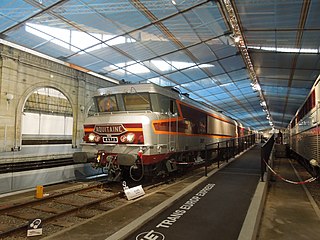
The Aquitaine was an express train that linked Bordeaux and Paris, France, between 1971 and about 1990. Operated by the Société Nationale des Chemins de fer français (SNCF), it was a first-class-only Trans Europ Express (TEE) until 1984 and then a two-class Rapide until discontinued, circa 1990.

The Saphir was an express train operated by the Deutsche Bundesbahn linking the port of Ostend with Dortmund as part of a link between London and the Ruhr. The name Saphir, German for sapphire, refers to the Belgian gemstone industry.
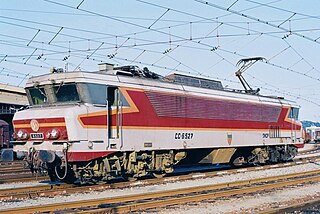
The Étendard was an express train that linked Paris and Bordeaux in France. Introduced in 1968, it was operated by the Société Nationale des Chemins de fer français (SNCF), and was initially a Rapide.

The Jules Verne was an express train that linked Paris and Nantes in France. Operated by the Société Nationale des Chemins de fer français (SNCF), it was the last new Trans Europ Express (TEE) to be introduced, in 1980.





















